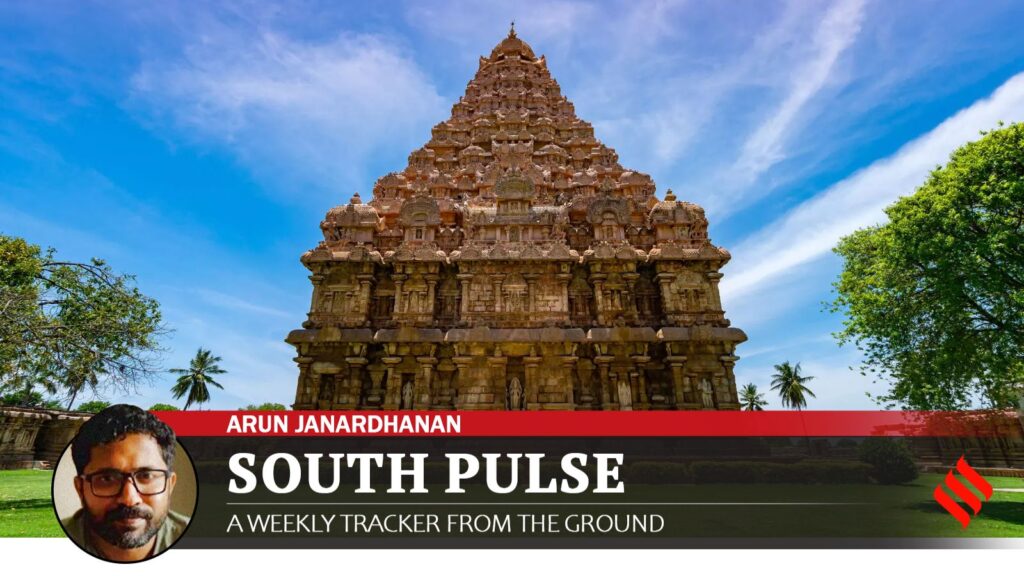An emperor who ruled a thousand years ago has drawn two political heavyweights into the same arena, with Tamil Nadu Chief Minister M K Stalin and Prime Minister Narendra Modi making separate efforts to honour the legacy of Rajendra Chola I (1014–1044 CE), the maritime monarch of the Chola dynasty.
While Stalin has declared the emperor’s birth anniversary as an official state celebration and announced several initiatives to commemorate his rule, Modi is set to visit Gangaikonda Cholapuram in Ariyalur district, which was once the Chola capital, on July 27 to unveil a commemorative coin and inaugurate an exhibition on Rajendra Chola’s northern conquest. The Union Ministry of Culture is hosting a four-day festival in the town commemorating 1,000 years of Rajendra Chola’s maritime expedition to Southeast Asia and the commencement of the construction of the Gangaikonda Cholapuram temple.
However, at stake is more than ritual commemoration. This moment signals an attempt to reframe Indian historical memory, with Rajendra Chola’s legacy leveraged through distinct ideological lenses: Stalin’s Dravidian federalism and Modi’s pan-India nationalism.
Rajendra Chola inherited a powerful kingdom from his father Rajaraja I, but it was his bold campaigns from the Ganga to Suvarnadwipa (an ancient term for islands in Southeast Asia, including Java and Sumatra) that turned the Cholas into a pan-Asian maritime empire. In 1025 CE, he launched a naval expedition against the Srivijaya empire, targeting present-day Malaysia, Indonesia, and Thailand to assert trade dominance over the Malacca Strait. As historian Hermann Kulke has observed in Nagapattinam to Suvarnadwipa, the campaign was not a sporadic act of aggression but a deliberate assertion of maritime dominance and prestige.
An engineering marvel
To commemorate his successful northern expedition, Rajendra Chola established Gangaikonda Cholapuram and ceremonially poured Ganges water brought back by his army into a vast man-made reservoir known as the Cholagangam tank, locally referred to as Ponneri. This act was immortalised in copper plate inscriptions, including those cited by K A Nilakanta Sastri in The Cholas, describing how Rajendra created a “liquid pillar of victory (ganga-jalamayam jayastambham) using sacred water from the Ganga.
According to the Trichinopoly Gazetteer (1855 edition) by British civil service officer F R Hemingway, the Cholagangam tank once irrigated approximately 1,564 acres of land. Later reports note that the embankment extended some 25 km, with multiple sluices engineered to manage water flow.
The tank, once the hydrological heart of Gangaikonda Cholapuram and an engineering marvel, now lies in disrepair. As recorded in the Trichinopoly Gazetteer by Hemingway, the tank embankments were fortified by laterite stone and sluices designed to control sediment flow. The system included vortex-driven silt ejectors and square-shaped sediment traps, features that highlight the Chola dynasty’s advanced understanding of hydraulic engineering. In Lords of the Earth and Sea, author Anirudh Kanisetti writes that the Cholas were master builders of systems that not only sustained urban capitals but expanded imperial legitimacy through ecological control. Rejuvenating the tank, experts say, will restore biodiversity, recharge groundwater, and revive the intricate agricultural web once nourished by its waters, echoing Rajendra’s original vision of power drawn as much from land and water as from conquest.
The British dismantled much of the town’s granite fortifications in 1832 to construct the Lower Kollidam Anaicut, breaking promises to rebuild its outer wall. The destruction was resisted by locals who were reportedly punished for their defiance. “A promise was made that a brick wall would be built in place of the stone wall that was pulled down,” the 1855 Gazetteer mentions. “But it has never been redeemed.”
Competing narratives
In the quiet resurgence of Rajendra Chola, there are two competing political narratives. While Stalin’s is one of regional pride, water security, and cultural preservation, linking it to Dravidian legacy, Modi’s is a civilisational assertion that connects ancient Indian glory to present-day power.
In the lead-up to Aadi Thiruvathirai, the Tamil Nadu CM announced a Rs 19.2 crore redevelopment plan for the tank: Rs 12 crore for bund strengthening, desilting of 38 km of canals, renovation of sluices, and irrigation support for seven villages. Another Rs 7.2 crore will be used for converting the area into a tourist destination, with walkways, parks, children’s play areas, fencing, and CCTV surveillance.
Additionally, a museum will be built near the temple complex for Rs 22.1 crore to highlight the Chola empire’s overseas trade networks, temple architecture, and cultural achievements, a continuation of the state’s push to embed the Cholas into Tamil Nadu’s cultural-political imagination.
“In 2021, we declared Aadi Thiruvathirai a government holiday,” Stalin wrote on X on July 23. “Now we are taking steps to showcase Rajendra Chola’s greatness to the world.”
The PM visit also carries its symbolic weight. On Sunday, he will unveil a commemorative coin to mark the 1,000th anniversary of Rajendra Chola’s Gangetic campaign, while musician Ilaiyaraaja is set to perform a 20-minute concert. An exhibition will showcase trophies and miniature sculptures from the Chola period. The town, which British officers compared to ancient Babylon, is being repainted and refenced.
By elevating figures such as Rajendra Chola, who expanded Hindu temple networks and maritime trade routes, the BJP aims to politically articulate a version of Indian history that is expansive, powerful, and deeply rooted in pre-Islamic grandeur. But as Kanisetti writes, Chola imperialism was not strictly religious: it was pragmatic, often secular, and grounded in trade diplomacy. Tamil merchant guilds such as the Manigramam and Ayyavole prospered under royal patronage, and epigraphs across Southeast Asia confirm commercial ties rather than religious zeal.
A millennium after Rajendra’s ships left Tamil shores for faraway islands, his legacy is back at the centre of a different expedition. As historian Tansen Sen writes in The Military Campaigns of Rajendra Chola, Rajendra’s campaigns were not about empire-building or expansionism in the modern sense but “strategic signalling” to regional powers, asserting Tamil commercial presence across Asia.

